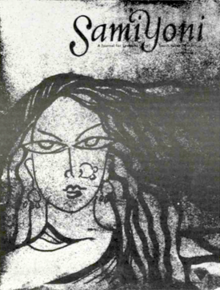 | |
| Editor | Neesha Dosanjh |
|---|---|
| First issue | March 1993 |
| Final issue | 1994 |
| Country | Canada |
| Based in | Toronto |
| Language | English |
| OCLC | 70728464 |
SamiYoni (sometimes spelled Sami Yoni) was a Canadian magazine for lesbians of South Asian descent, published between 1993–1994. [1] [2]
History
According to a description in The Rainbow Book, "SamiYoni is a journal for Lesbians of South Asian descent. We publish visual arts, poetry, prose, essays, etc. Our objective is to create a space for the expression of South Asian Lesbians and for the political and creative ideas of South Asian Lesbians." [1]
Reviews compared SamiYoni to other South Asian diasporic LGBTQ publications like Anamika, Shamakami, Trikone, Khush Kayal, Shakti Khabar, and Shakti Report. [3] [4] [5]
The first issue was published in March 1993, and launched at the Desh Pardesh festival. It was 38 pages long, and included work from 18 South Asian Canadian lesbians, many from the Toronto area. The magazine closed by 1994. [6] [7] [8]
It was edited by bookseller Neesha Dosanjh. [9] [10] [11] She described the origin of the publication in an editorial in the first issue: [12] [13]
In the summer of 1992, a young South Asian lesbian came to me at the Toronto women's bookstore and asked, "Neesha, are there any books, anthologies, anything written by lesbians of South Asian descent?"
Together we scoured the lesbian section, the anthologies, the Asian women's section, magazines, journals. We couldn't find anything.
I was exasperated. I tried to think of a forum, any forum in Toronto, for lesbians of South Asian descent to voice how we feel, think, speak, look, hear... I was surprised that nothing was coming to mind. So I set about trying to create one version of that space. I called all the South Asian lesbians that I know here, in Toronto, got together names and numbers of others in Canada, and started bugging their asses for submissions.
See also
- Anamika newsletter, 1985-1987
- Trikone magazine
- Shamakami magazine
- Timeline of South Asian and diasporic LGBT history
References
- ^ a b The Rainbow Book : a cross Canada directory of community services for lesbians, gay men, bisexuals, transsexuals, transgenderists and transvestites. Toronto: Coalition for Lesbian & Gay Rights in Ontario. 1996. p. 88.
- ^ Zimmerman, Bonnie (2012). Encyclopedia of Lesbian Histories and Cultures. Routledge. p. 144. ISBN 978-1-136-78751-5.
- ^ Lim-Hing, Sharon (1994). The Very Inside: An Anthology of Writing by Asian and Pacific Islander Lesbian and Bisexual Women. Sister Vision Press. p. 412. ISBN 978-0-920813-97-3.
- ^ Joseph, Sherry (2005). Social work practice and men who have sex with men. New Delhi ; Thousand Oaks, Calif. : SAGE Publications. p. 80. ISBN 978-0-7619-3351-9.
- ^ Srivastava, Vinita (1994). "You Stretch Me". Border/Lines (32). Downsview, Ontario, Canada: 41. ISSN 0826-967X. OCLC 1166971995.
- ^ "Gay, Lesbian, Bisexual, Transgender Periodicals". Northwestern University Libraries. Retrieved 2023-05-22.
- ^ "Queer & Trans". Brown Canada. 2017-03-24. Archived from the original on March 24, 2017. Retrieved 2023-05-22.
- ^ Mehat, Sur (May 1993). "Review: SamiYoni: A Journal for South Asian Lesbians". Kinesis: 17. ISSN 0317-9095.
- ^ Minemura, Emi (1996). Asian Pacific Islander Lesbian and Bisexual Women in North America: Activism and Politics. Michigan State University. American Studies Program. p. 54.
- ^ "Neesha Dosanjh". Vtape. Retrieved 2023-05-22.
- ^ "Our Own Presses". Feminist Bookstore News. 16 (2): 96. August 1993 – via JSTOR.
- ^ Dosanjh, Neesha (1997). "Sami Yoni" (PDF). Rungh. 3 (4): 9. ISSN 1188-9950. OCLC 1082160339.
- ^ Dosanjh, Neesha. "Editorial". SamiYoni. 1 (1).
- Defunct LGBT-related magazines published in Toronto
- Defunct feminist magazines
- Lesbian history in Canada
- Lesbian feminist magazines
- Defunct lesbian-related magazines
- Magazines established in 1993
- Magazines disestablished in 1994
- Newsletters
- South Asian Canadian culture
- Multicultural and ethnic magazines in Canada
- South Asian mass media in Canada
- Feminist magazines published in Canada
- LGBT-related magazine stubs